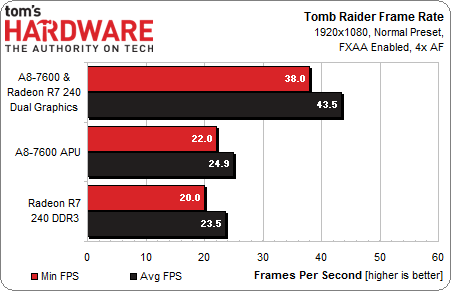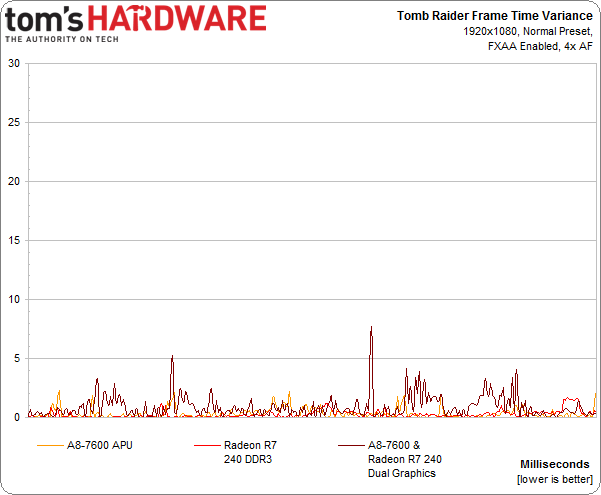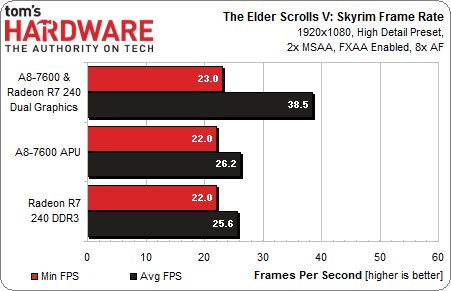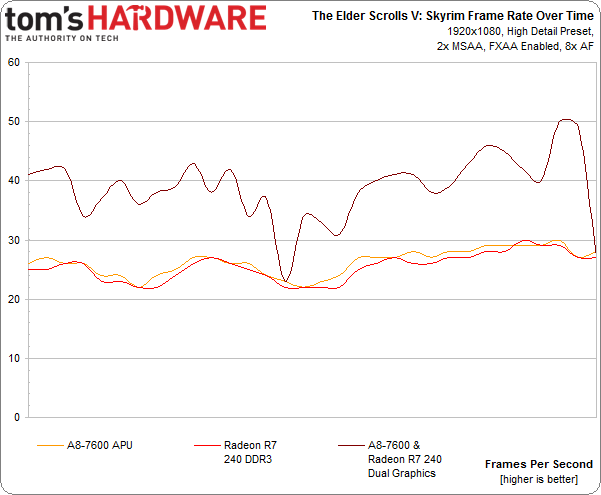AMD A10-7850K And A8-7600: Kaveri Gives Us A Taste Of HSA
We've spent the days following CES benchmarking two of AMD's new Kaveri-based APUs. Do the Steamroller x86 architecture, GCN graphics design, and HSA-oriented features impress, or do they come up short against Intel's value-oriented Haswell-based parts?
Dual Graphics: Does Kaveri Fix CrossFire's Problems?
If you're not already familiar with AMD's Dual Graphics technology, you can think of it as a form of CrossFire that pairs an APU and discrete GPU to extract additional performance. The company started touting Dual Graphics back in the Llano days, so we published an in-depth examination of its inner workings back in August of last year (AMD Dual Graphics Analysis: Better Benchmarks; Same Experience?).
Back then, we observed that Fraps suggested that the add-in GPU was adding a lot of extra speed. However, our video-based FCAT testing showed a lot of those new frames were getting dropped and chopped off, ultimately yielding an experience no better than integrated graphics operating on its own. To demonstrate this phenomenon to our readers, we captured lossless video from the graphics card and uploaded it to YouTube with instructions on how to watch at 60 Hz. If you want more information, and haven't already seen the story we wrote, you owe it to yourself to check it out.
It took a few months, but AMD says it addressed the problem in its beta Catalyst 13.35 driver. We didn't have much time to prepare for this piece, but we did manage to test with Tomb Raider, BioShock Infinite, and The Elder Scrolls V: Skyrim. Previously, all three games fared well in Fraps and fell on their faces during our FCAT analysis.
We begin with Tomb Raider. These results were recorded using FCAT, so dropped and runt frames are excluded; the results can be believed because we're pulling the output straight from the DVI port.
There's an almost-100% boost with Dual Graphics enabled. But before we get too excited, let's look at frame time variance:
Latencies appear low, and lower is better. But to make sure our quantitative data corresponds to what we see, let's revisit the video like we did in our previous Dual Graphics analysis.
Our video jives with the data we collected; Dual Graphics appears to work much better in Tomb Raider than it did on AMD's previous-gen platform.
Get Tom's Hardware's best news and in-depth reviews, straight to your inbox.
Next up is BioShock Infinite, which has also been problematic in the past.
Frame rates clearly jump in BioShock thanks to Dual Graphics, though we do observe more of that nasty frame time variance.
The last title we had time for was The Elder Scrolls V: Skyrim.
FCAT tells us that Skyrim's average frame rate is up with Dual Graphics enabled. However, the game's minimum performance level doesn't increase. A look at frame rate over time reveals a couple of valleys, one of which corresponds to a spike in the frame time variance chart. Worse, the Dual Graphics comparison video doesn't look any smoother than the A8-7600 or Radeon R7 240 on their own. If anything, it even looks choppier at times.
Skyrim is known for its frame time variance issues, and we've seen other dual-GPU configurations behave strangely in the game. Although we plan to write a more thorough follow-up to our first excursion with Dual Graphics, we're at least glad that frame pacing appears enabled in the company's driver. As for the value analysis, we have to save that for next time.
Current page: Dual Graphics: Does Kaveri Fix CrossFire's Problems?
Prev Page Gaming: The Elder Scrolls V: Skyrim And World Of Warcraft Next Page Results: Synthetics-
Someone Somewhere Yeah, almost all the diagrams refer to the 4760K.Reply
Given that AM3+ looks like it's done, it would have been nice to see a 6-core chip. Still, one of these may end up in my next laptop. -
spp85 A10-7850k is slower than A10-6800K ?? WTF. Its all hype than actual performance to the table. Even on OpenCL GPU accelerated apps doesn't have any advantage with A10-7850k over i5 or sometimes i3 CPUs. Hopeless is what I feel about AMD CPUs.Reply -
Someone Somewhere Reply12454254 said:A10-7850k is slower than A10-6800K ?? WTF.
I got the opposite impression. Which graph are you looking at? -
Jaroslav Jandek Thank you for the article (especially the power consumption measurements), Chris. It is definitely an improvement over Richland but kind of boring (disappointingly expectable).Reply
I really like where AMD is going (HSA, GCN and TrueAudio).Too bad the manufacturing process of GlobalFoundries just can't match Intel's.
Also, it would be interesting to see the new Bay Trail Pentium or Celeron CPUs (whichever is closer in performance) in the Efficiency graphs. -
Someone Somewhere I'm fairly sure that this is on TSMC's 28nm node. GlobalFoundries can't do that yet; this is on the same process used for AMD GPUs currently.Reply -
Jaroslav Jandek Reply
28nm SHP from GlobalFoundries. AMD bought over $1 billion worth of wafers from them in december...12454280 said:I'm fairly sure that this is on TSMC's 28nm node. GlobalFoundries can't do that yet; this is on the same process used for AMD GPUs currently.
I guess you have been reading the articles from a year ago about AMD still using TSMC despite promises of GlobalFoundries' new 28nm SHP process. -
jacobian I don't really believe into the whole HSA smoke-screen. By the time HSA-enabled apps take off, you will be ready to upgrade from your CPU again. The one terrible truth that stands out right now is that at current prices, the flagship Kaveri A10 doesn't make any sense whatsoever. Kaveri A8? Maybe. Richland A10-6790K? Perhaps. But the Kaveri A10 at $180 is a just a joke, specially after all that hype.Reply -
Someone Somewhere CPUs are usually released at ridiculous prices, and come down over a month or two.Reply















